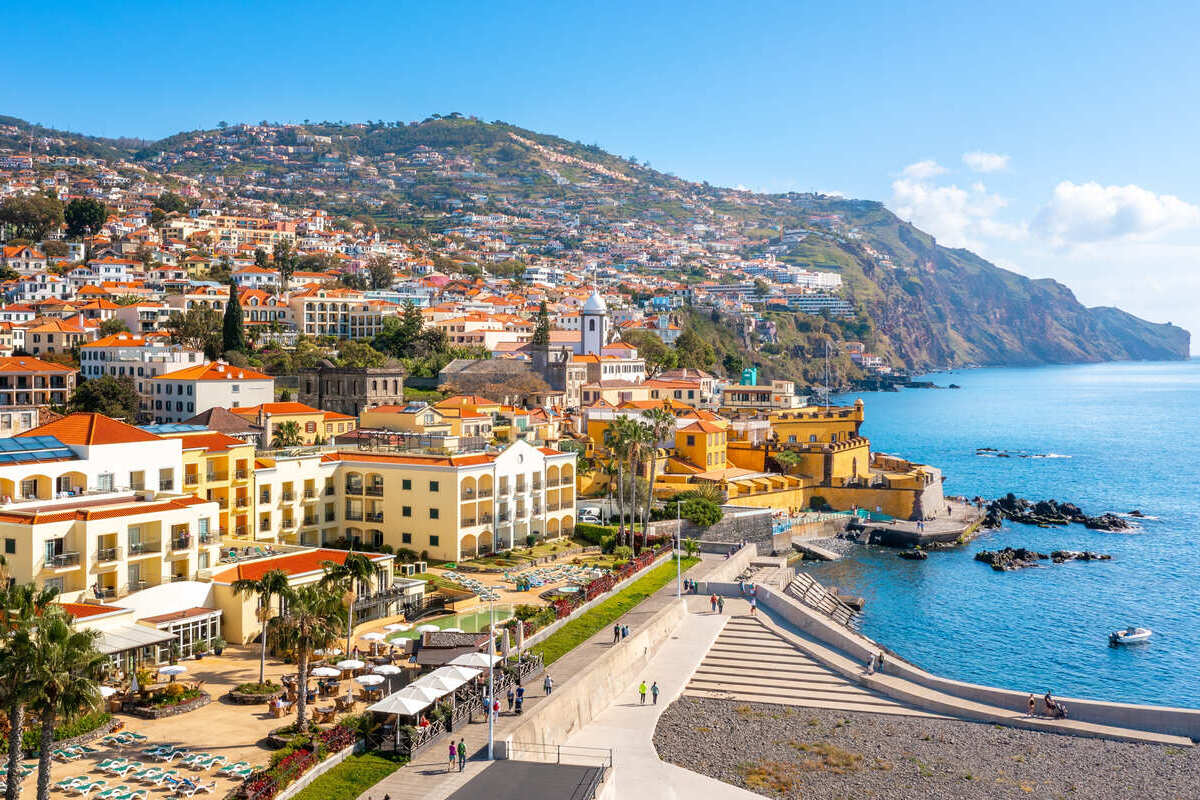Last Updated
If you’re planning on crossing the pond this season, the Mediterranean is likely to be at the top of your list.
We get it, it is home to the most beautiful, unspoiled coastal scenery, waters of the brightest-blue, and picture-perfect towns that look ripped out the pages of a fairytale novel, but there’s just one catch many are failing to take into consideration.
Never mind the overtourism and inflated prices, it is flaming hot right now, with wildfires raging on in Greek islands and travel alerts being issued for parts of Spain and Italy as temperatures soar above safe levels:

We’re not talking a cozy, balmy warm; we’re talking torrid, unmanageable, get-me-out-of-here kind of warm.
Seeing some hotels in Greek islands already being evacuated again as dangerous fires break out, we wouldn’t be the first ones to bank on a Mediterranean getaway this season.
But there may be an alternative.
Away from the Med, there’s this paradisiacal Portuguese island with emerald nature and perfect weather––not unpleasantly warm, but not too chill, either––and you can even fly there nonstop from the States:
It’s Time You Stop Sleeping On Madeira


Though it is hundreds of miles away from Portugal’s mainland, and in fact, closer to the coast of West Africa than it is to Europe, Madeira is a remote Atlantic island the Portuguese have held since the 15th century, and believe it or not, an increasingly-popular year-round destination.
Before we get to the actual good stuff, here’s a couple of equally-interesting facts about Madeira:
Despite being an integral part of Portugal, it is a self-governing autonomous community with a distinct character, and at times, you might even struggle to consider both as being part of the same national entity.


For starters, mainland Portugal is much older: its History starts as far back as Gaelic tribes and the Ancient Roman Empire, and similarly to Spain, it has verdant plains, a sandy coast and exceedingly-high temperatures over summer.
Madeira is a volcanic island traversed by towering peaks. As it is nearer the tropics–once again, it’s in proximity to Africa as opposed to its home continent–seasons are not as well defined as they are in the European mainland.
Now we get to the good part.
Why Madeira Is A Year-Round Sunny Paradise


Madeira is nearer the tropics, where the climate remains largely at a constant irrespective of seasonal changes, and come summer or winter, it’s never too hot, nor too cold to visit:
Right now in Funchal, the coastal capital of Madeira, it’s a pleasant 82.4°F during the day, dropping to 71.6°F in the evening, while other parts of the island that are higher up, it ranges from 55.4°F to an acceptable 69.8°F.
The trend repeats itself throughout the year, with an only-moderately chilly 69.8°F in Funchal in December, and some rain expected, but not an awful lot.


As you might have guessed, wildfires over summer are an uncommon occurrence, and when winter comes, snow is an even rarer phenomenon unless you’re climbing up to some of the tallest peaks where some dusting is expected.
In other words, you won’t be risking heat exhaustion while exploring Madeira, and boy, is there an entire world of natural wonders to be braved:
The Most Beautiful Nature Anywhere In Europe


Mainland Portugal is best known for its rich Ancient Roman and Baroque heritage, with cities like Lisbon and Porto concentrating a great deal of the country’s regal palaces and most ornate churches, but Madeira, on the other hand, is all about the thriving nature.
We’re talking epic hikes into the sunrise, swimming off a pristine, rugged coast in nature-made volcanic pools, footpaths locally known as levadas that lead to lush-green jungles and hidden waterfalls, and botanical gardens that seem to be in a permanent state of bloom.
It’s no wonder Madeira is called Land of Eternal Spring (it might as well be):
Epic Hikes Await


The most epic hike in Madeira, the climb from Areeiro to Ruivo Peak, takes you through highland scenery, crossing tunnels and zig-zagging across the dramatic landscape.
In the end, you are rewarded with sweeping vistas of the sea of mountains from the island’s tallest summit.
Get your comfy hiking shoes on, and make sure you pack plenty of water bottles and protein bars: there’s no stopping once you cross the infamous Stairway to Heaven (and if you suffer from vertigo, make sure you don’t look down).


Luckily for beginners like us, we can always book a sunset hike tour dropping us off at the first peak, and then proceed to summit the second––and highest one––before getting picked up again, for a fixed price of $35.98 on GetYourGuide.
There are many more peaks to conquer all around Madeira, 147 mountains to be precise, but you’ll want to set some time aside for some beachside relaxation.
Volcanic Pools And Mystical Forests


For that, head to Porto Moniz, in the island’s north, where you’ll find some of the best volcanic pools with crystal-clear water, which as you may know, are not as easy to come across in the Atlantic as they are in the Med.
Porto Moniz is also a lively resort town lined with beachfront hotels and oceanfront restaurants, and it’s one of the gateways for reaching the UNESCO-listed Fanal, an eerie ancient forest dating back millions of years that’s best experienced at dawn, when the mist is yet to dissipate.


Perhaps the most iconic postcard shot in all of Madeira, Valley of the Nuns is yet another popular stopover for nature enthusiasts: a sleepy isolated village nestled in the center of a valley, it is flanked by imposing fog-crowned elevations almost bordering on ethereal.
For those epic coastal views, drive towards Ponta de São Lourenço, Madeira’s easternmost tip, and a rocky peninsula jutting out into the azure Atlantic: the kind of stuff that needs to be seen with your own eyes to be believed.
Has Madeira Been An Underrated Cultural Hotspot All Along?


The nature may be the star of the show in Madeira, but let’s not forget about its cultural contributions:
More specifically, the capital, Funchal, is a prime example of Portuguese colonial architecture, with its old cathedral, built from blocks of native volcanic rock and with a magnificent roof of cedar wood, the late medieval Convent of Santa Clara, and a well-preserved Old City.
Taking the cable car from the maze of cobbled streets starting from the ever-busier Central Market, you’ll hover above the terracotta roofs of historic Funchal, all the way up to the hilly suburb of Monte (translatable as Mount), best known for its exotic Tropical Garden.


For enthusiasts of recent history, particularly football, you don’t want to miss the CR7 Museum, which is celebratory of Funchal’s biggest international export: Cristiano Ronaldo, who was born and raised in Madeira before taking on the world.
Funchal is up there with Lisbon as one of Portugal’s trendiest summer getaways, and one of Europe’s fastest-growing city destinations, according to a recent research published by ForwardKeys.
A short 24-minute drive from Funchal, Ponta do Sol is a dreamy oceanfront village surrounded by banana plantations, and its Nossa Senhora da Luz Church is among Madeira’s last-surviving from the early colonial settlement.


Further west of Ponta do Sol, the laid-back coastal town of Ribeira Brava is perfect for unwinding, sampling traditional Portuguese food––the drenched-in-oil lagareiro octopus is a must-try delicacy––and going for long promenade walks.
On the north coast of the island, there is yet another cultural hub to be found in Santana, where houses are built in a unique triangular shape, and topped with thatched roofs––in the center of town, the whitewashed Baroque Santana Church is not to be missed.
Madeira Is Incredibly Affordable By European Standards


Budget-wise, Madeira is one of the cheapest summer hotspots in Europe at present, with particularly-low prices observed for food and drinks, and attractive room rates.
With local restaurants boasting an abundance of local produce and many tourism providers (hotels included) growing their own vegetables and fruit, consumer prices in Madeira are markedly lower than those in the European mainland.
On average, tourists spend $34 on meals per day, as estimated by Budget Your Trip, though that is unlikely to include elaborate, three-course dinners in Funchal’s top-rated Alta Vista Restaurant.


If you’re keen on keeping costs down, there are still plenty of $1.50 custard tarts, Portuguese-style, delicious $3 savory pastries, and $2.18 poncha shots to be had.
As for accommodation, the average visitor spends $113 per night on hotels, though there’s far-cheaper privately-managed guesthouses listing rooms from $68 on Booking.com, like Residencial Chafariz in Funchal, and Pensão Fernandes in Porto Moniz, costing $87 to book per night.
Overall, a one-week trip to Madeira can cost $701 per person, or the equivalent in euro, excluding flights.
Fly Nonstop From Boston And Toronto To Madeira


Recently, Portuguese carrier Azores Airline launched new nonstop flights from Boston, Massachusetts (BOS), and Toronto, Canada (YYZ) to Funchal (FNC), eliminating the need for Americans and Canadians alike to first touch town in continental Portugal ahead of connecting onward to Madeira.
On both routes, flights operate weekly, with departures from Boston on Tuesdays and returns from Funchal scheduled for the following Wednesdays; as for Toronto, departures take place on Saturdays, and homebound flights leave on Fridays.


Azores Airlines has deployed a Boeing 767-300ER on the new routes and plans to maintain this Transatlantic service throughout the peak travel season.
On top of Boston and Toronto, Azores Airlines already transports passengers from New York (JFK) to Funchal every Sunday, with return trips scheduled for Mondays.
One-way flights can be booked directly through their official website for as cheap as $282.10, with the outbound journey taking only 6 hours.


✈️Join Our Travel Off Path Community Forum: Where travelers unite, ask questions, share experiences and even find like-minded travel buddies!
SUBSCRIBE TO OUR LATEST POSTS
Enter your email address to subscribe to Travel Off Path’s latest breaking travel news, straight to your inbox.
This article originally appeared on TravelOffPath.com
Opinions expressed here are the author’s alone, not those of any bank, credit card issuer, hotel, airline, or other entity. This content has not been reviewed, approved or otherwise endorsed by any of the entities included within the post.





